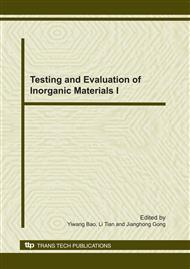p.211
p.215
p.219
p.223
p.226
p.231
p.235
p.238
p.245
Sintering Behavior of Ceramic Green Body by Thermal Analysis Techniques
Abstract:
A series of physical and chemical changes, including the shrinkage and the phase transformation, will continuously take place during the sintering process of ceramic green body, which is important for designing a scientific and economic sintering schedule. The sintering behavior of two electrical porcelains and a structural tile were investigated using thermal analysis techniques. The dehydration, phase changes and densification of ceramic green body during sintering process were characterized by DSC-TG and thermal expansion curves. The sintering temperature range of ceramic green body was measured by thermal dilatometer with different heating rates. The sintering temperature Ts is linear to the logarithm of heating rate V. The results were compared with that measured by conventional refractoriness tester. The Ts is much more accurate to evaluate the sintering behavior of ceramic green body from the thermal analysis technique than that from the traditional method. The projected sintering schedule is very concordant to the experimental sintering results.
Info:
Periodical:
Pages:
226-230
Citation:
Online since:
December 2010
Authors:
Keywords:
Price:
Сopyright:
© 2011 Trans Tech Publications Ltd. All Rights Reserved
Share:
Citation:


